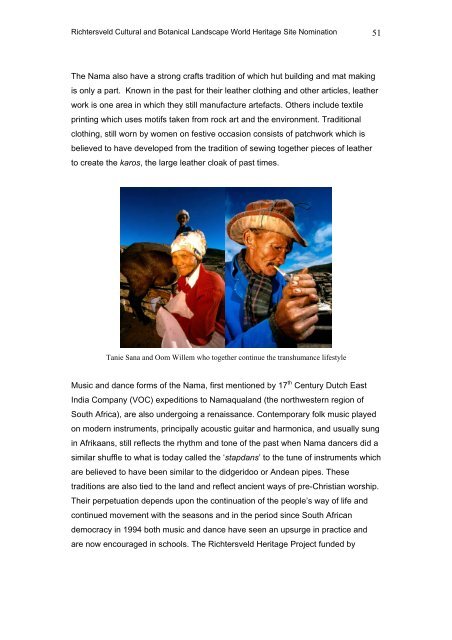the richtersveld cultural and botanical landscape - SAHRA
the richtersveld cultural and botanical landscape - SAHRA
the richtersveld cultural and botanical landscape - SAHRA
You also want an ePaper? Increase the reach of your titles
YUMPU automatically turns print PDFs into web optimized ePapers that Google loves.
Richtersveld Cultural <strong>and</strong> Botanical L<strong>and</strong>scape World Heritage Site Nomination 51<br />
The Nama also have a strong crafts tradition of which hut building <strong>and</strong> mat making<br />
is only a part. Known in <strong>the</strong> past for <strong>the</strong>ir lea<strong>the</strong>r clothing <strong>and</strong> o<strong>the</strong>r articles, lea<strong>the</strong>r<br />
work is one area in which <strong>the</strong>y still manufacture artefacts. O<strong>the</strong>rs include textile<br />
printing which uses motifs taken from rock art <strong>and</strong> <strong>the</strong> environment. Traditional<br />
clothing, still worn by women on festive occasion consists of patchwork which is<br />
believed to have developed from <strong>the</strong> tradition of sewing toge<strong>the</strong>r pieces of lea<strong>the</strong>r<br />
to create <strong>the</strong> karos, <strong>the</strong> large lea<strong>the</strong>r cloak of past times.<br />
Tanie Sana <strong>and</strong> Oom Willem who toge<strong>the</strong>r continue <strong>the</strong> transhumance lifestyle<br />
Music <strong>and</strong> dance forms of <strong>the</strong> Nama, first mentioned by 17 th Century Dutch East<br />
India Company (VOC) expeditions to Namaqual<strong>and</strong> (<strong>the</strong> northwestern region of<br />
South Africa), are also undergoing a renaissance. Contemporary folk music played<br />
on modern instruments, principally acoustic guitar <strong>and</strong> harmonica, <strong>and</strong> usually sung<br />
in Afrikaans, still reflects <strong>the</strong> rhythm <strong>and</strong> tone of <strong>the</strong> past when Nama dancers did a<br />
similar shuffle to what is today called <strong>the</strong> ‘stapdans’ to <strong>the</strong> tune of instruments which<br />
are believed to have been similar to <strong>the</strong> didgeridoo or Andean pipes. These<br />
traditions are also tied to <strong>the</strong> l<strong>and</strong> <strong>and</strong> reflect ancient ways of pre-Christian worship.<br />
Their perpetuation depends upon <strong>the</strong> continuation of <strong>the</strong> people’s way of life <strong>and</strong><br />
continued movement with <strong>the</strong> seasons <strong>and</strong> in <strong>the</strong> period since South African<br />
democracy in 1994 both music <strong>and</strong> dance have seen an upsurge in practice <strong>and</strong><br />
are now encouraged in schools. The Richtersveld Heritage Project funded by

















